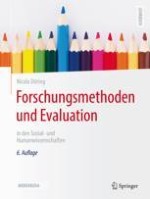2023 | OriginalPaper | Buchkapitel
14. Bestimmung von Teststärke, Effektgröße und optimalem Stichprobenumfang
verfasst von : Nicola Döring
Erschienen in: Forschungsmethoden und Evaluation in den Sozial- und Humanwissenschaften
Verlag: Springer Berlin Heidelberg
Aktivieren Sie unsere intelligente Suche, um passende Fachinhalte oder Patente zu finden.
Wählen Sie Textabschnitte aus um mit Künstlicher Intelligenz passenden Patente zu finden. powered by
Markieren Sie Textabschnitte, um KI-gestützt weitere passende Inhalte zu finden. powered by
